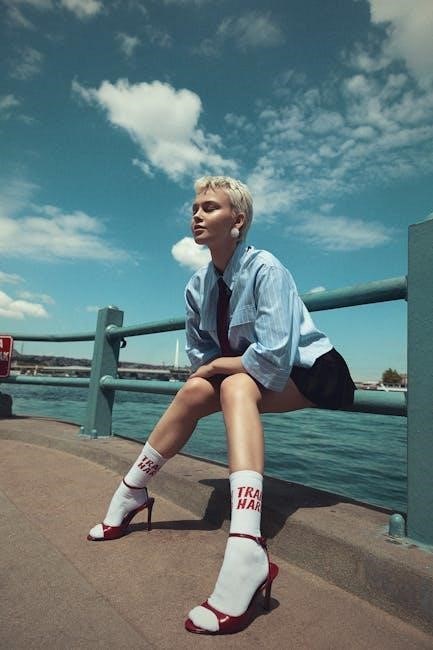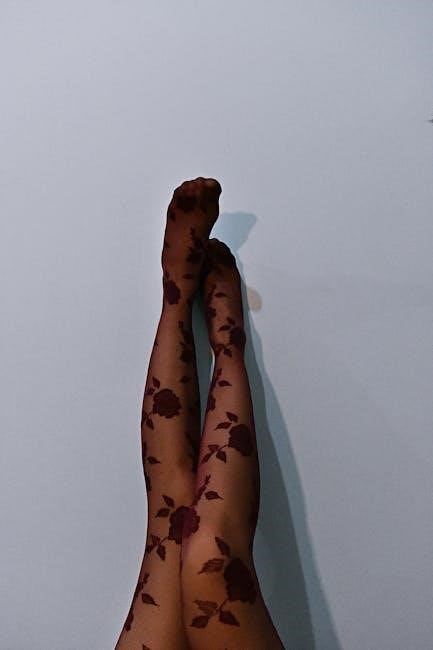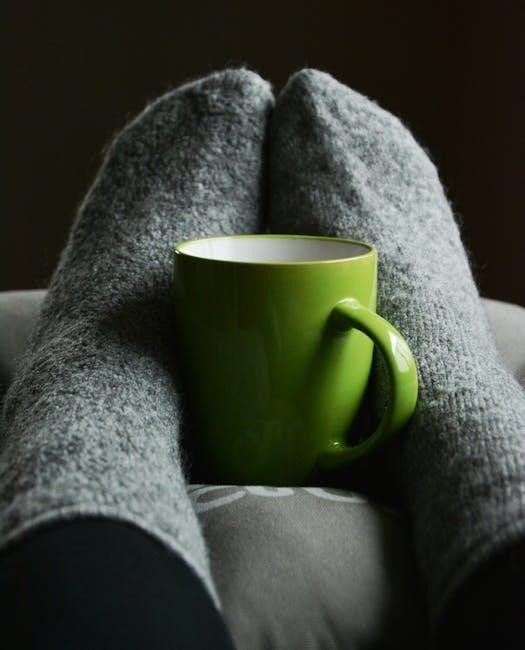Understanding sock size guides is essential for ensuring comfort and proper fit. These guides help convert shoe sizes to sock sizes for men, women, and kids, ensuring the best match for any footwear. Whether you’re shopping for everyday wear or athletic socks, knowing your size ensures optimal comfort and performance. Sock size charts vary by brand and type, so referencing them before buying is crucial for making informed purchases.
Importance of Proper Sock Fit
Proper sock fit is crucial for comfort, support, and overall foot health. Ill-fitting socks can cause discomfort, blisters, or restricted movement, impacting daily activities and athletic performance. Socks that are too tight may impede circulation, while those too loose can bunch up and cause friction. Correct sizing ensures optimal cushioning, moisture management, and arch support, enhancing overall wearability. Additionally, proper fit prevents issues like toe crowding or heel slippage, which can lead to long-term foot problems. Selecting the right size guarantees a better experience, whether for casual wear or intense activities, making it essential to refer to sock size charts for accurate measurements.

Understanding Sock Size Charts
Sock size charts are tools that help determine the correct sock size based on foot length and shoe size. They typically include measurements for men, women, and kids, ensuring a proper fit. These charts often convert shoe sizes into corresponding sock sizes, accounting for variations in foot shape and sock thickness. By referencing these guides, individuals can avoid issues like tight socks that restrict circulation or loose socks that bunch up. Sock size charts may also consider factors like fabric type and activity level, ensuring comfort and performance. They serve as a practical reference for shoppers to make informed purchasing decisions and enjoy a better wearing experience.

Men’s Sock Size Guide
Men’s sock sizes typically range from small to extra-large, corresponding to shoe sizes. Standard sizes include S (fits shoe sizes 5-7), M (7-9), L (9-12), and XL (12-15). These guides help ensure a comfortable, proper fit for everyday or athletic wear.
Shoe Size to Sock Size Conversion for Men
Converting men’s shoe sizes to sock sizes ensures a proper fit. Generally, a shoe size of 5-7 corresponds to a small sock size, while 7-9 fits a medium. Larger sizes, such as 9-12, align with a large, and 12-15 match an extra-large. This guide helps men choose socks that match their footwear, ensuring comfort and preventing issues like tightness or slippage. However, factors like foot shape and brand variations can affect fit, so double-checking size charts is recommended. For accurate results, always refer to the specific brand’s sizing guide before making a purchase.
Standard Men’s Sock Sizes (S, M, L, XL)
Men’s sock sizes are categorized as Small, Medium, Large, and Extra-Large. These sizes correspond to specific shoe size ranges, ensuring a tailored fit. A Small typically fits shoe sizes 5-7, while Medium accommodates sizes 7-9. Large covers shoe sizes 9-12, and XL is designed for sizes 12-15. These standard sizes provide a general guideline, but variations may exist between brands. Always check the specific brand’s size chart for accuracy, as sock sizes can differ based on fabric, length, and cushioning. Proper fit ensures comfort and prevents issues like tightness or slipping during wear.

Women’s Sock Size Guide
A comprehensive guide to help women find their perfect sock size, ensuring comfort and style. Sizes are typically based on shoe size conversions and standard fits, varying by activity and fabric type to meet individual needs.
Shoe Size to Sock Size Conversion for Women
Converting shoe size to sock size for women is straightforward, with sock sizes generally aligned to footwear measurements. A small sock size typically fits shoe sizes 5-7, while medium accommodates 7-9, large fits 9-12, and X-Large suits 12-15. These conversions ensure a snug, comfortable fit. However, some brands offer more precise sizing, so checking specific charts is recommended. Factors like fabric thickness and intended use (e.g., athletic or casual) may also influence the fit. Always refer to the brand’s size guide for the most accurate match, ensuring optimal comfort and performance for any activity or occasion.

Standard Women’s Sock Sizes (S, M, L, XL)
Standard women’s sock sizes are categorized as Small (S), Medium (M), Large (L), and Extra-Large (XL). These sizes correspond to specific shoe size ranges, ensuring a comfortable fit. A Small typically fits shoe sizes 5-7, while Medium suits 7-9. Large accommodates shoe sizes 9-12, and XL fits 12-15. These sizes are designed to provide a snug yet comfortable fit for various foot lengths. However, sock fit can vary based on fabric thickness, sock length, and personal preference. Always check the brand’s size chart for precise measurements, as some may differ slightly. Proper sizing ensures optimal comfort and performance for daily wear or specific activities.

Kids’ Sock Size Guide
Kids’ sock sizes are determined by shoe size and age, ensuring proper fit and comfort. Sizes range from toddler to youth, with conversions aligned to US shoe sizes. By age 10, many kids fit into standard women’s sizes. Always check size charts for accurate measurements, as brands may vary slightly. Proper sizing ensures comfort and prevents blisters, making it essential for everyday wear and activities.
Shoe Size to Sock Size Conversion for Kids
Converting kids’ shoe sizes to sock sizes ensures a perfect fit. Typically, sock sizes for kids are categorized as Small, Medium, and Large, corresponding to specific shoe size ranges. For example, a size S sock fits shoe sizes 9-11.5, while a size M fits 12-2.5, and a size L fits 3-6. These conversions vary slightly by brand but generally align with standard shoe size charts. By around age 10, many kids transition into smaller adult sock sizes. Always consider growth and activity level when selecting sizes to ensure comfort and durability. Measuring foot length can also provide a more accurate fit.
Age-Based Sock Size Chart for Children
An age-based sock size chart helps determine the right fit for children. Infants (0-3 months) typically wear size 3-4, while toddlers (1-2 years) fit sizes 5-6. Children aged 3-4 years wear size 7-8, and those aged 5-12 years fit sizes 9-13. These sizes correspond to standard sock sizes for kids. By around age 10, many children transition into smaller adult sock sizes. Always consider growth spurts and activity levels when choosing sizes, as these factors can affect fit and comfort. Referencing an age-based chart ensures the perfect match for your child’s needs.

How to Measure Your Foot for Sock Size
Stand on a flat surface with your heel against a wall. Mark the longest point of your foot and measure the length to determine your sock size accurately.
Step-by-Step Guide to Measuring Foot Length
To accurately measure your foot length for sock sizing, place a sheet of paper against a wall and stand on it with your heel touching the wall. Mark the farthest point of your foot with a pencil. Measure this distance using a ruler, ensuring it’s straight and level. This measurement will help determine your sock size. Repeat for both feet, as sizes may vary slightly. Use this length to refer to sock size charts, ensuring a comfortable and proper fit for your socks.
Understanding Foot Circumference Measurements
Foot circumference measurements are crucial for determining the perfect sock fit. To measure, wrap a flexible tape measure around the widest part of your foot, just above the arch. Ensure the tape is snug but not tight. This measurement helps identify the sock’s width and ensures comfort. For accuracy, measure both feet, as they may differ slightly. Foot circumference, combined with length, provides a comprehensive size guide. This method is especially useful for athletic socks, where a secure fit is essential. Keep in mind that different brands may vary slightly in sizing due to fabric stretch and design.

Special Considerations for Sock Sizing
Fabric type, activity level, and personal comfort preferences influence sock size selection. Thicker fabrics may require a larger size, while high activity demands moisture-wicking materials for optimal performance.

Factors Affecting Sock Fit (Fabric, Length, Cushioning)
The fit of socks is influenced by fabric, length, and cushioning. Different fabrics, such as cotton, wool, or synthetic materials, offer varying levels of breathability and elasticity, affecting comfort. Sock length options, like no-show, crew, or over-the-calf, impact both style and functionality. Cushioning varies from thin, lightweight options to thick, padded designs, which are ideal for high-impact activities. Considering these factors ensures a personalized fit, whether for casual wear or athletic performance. Proper alignment of these elements with your needs enhances overall comfort and satisfaction. Always check the fabric blend, length, and cushioning level when selecting socks for optimal fit and functionality.
How Activity Level Impacts Sock Size Selection
Activity level significantly influences sock size selection, as different exercises require varying levels of support and cushioning. For high-impact activities, such as running or hiking, thicker, cushioned socks are recommended to absorb shock and reduce friction, which may necessitate a slightly larger size for comfort. Conversely, low-impact activities like yoga or casual wear may favor thinner socks for a snug fit. Over time, repeated motion can cause feet to swell, affecting sock fit. Therefore, it’s important to choose socks tailored to your activity level and consult size charts to ensure optimal comfort and performance.

Common Mistakes in Choosing Sock Sizes
A common mistake is assuming your sock size matches your shoe size without consulting a size chart. Ignoring fabric type and activity level can also lead to poor fit.
Mistakes to Avoid When Selecting Sock Sizes
When choosing sock sizes, a common error is assuming your sock size matches your shoe size without consulting a size chart. Many people overlook factors like foot circumference, fabric thickness, and activity level, which can affect fit. Ignoring the sock size chart provided by brands leads to discomfort and poor performance; Additionally, relying solely on general size labels (S, M, L) without measuring foot length can result in ill-fitting socks. Failing to account for growth in kids’ sock sizes or assuming all brands use the same sizing standards are other frequent mistakes. Always reference the specific size guide for the best fit.
Tips for Ensuring the Best Fit
To ensure the best fit, always refer to the sock size chart provided by the manufacturer, as sizes can vary between brands. Measure your foot length and circumference accurately, and consider factors like fabric type, cushioning, and activity level. Reading customer reviews can provide insights into how a specific brand’s socks fit. For kids, regularly update sizes as they grow. Be mindful that unisex socks may fit differently than gender-specific ones. Finally, if purchasing socks for specialized activities, check for custom sizing options to ensure optimal comfort and performance.